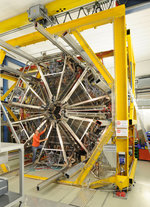HADES detector - Where does the mass come from?
Research into atomic nuclei and their basic building blocks promises to yield answers to some of the most elementary questions of science. These questions include: “What is the basic structure of matter?” and “Why does mass exist?” The HADES experiment at GSI aims to shed light on the properties of nucleons — the particles that make up atomic nuclei — and thereby unlock some of the secrets of quantum physics.
One established way of investigating particles is to accelerate them to extremely high velocities, cause them to collide with one another, and study the resulting debris in order to draw conclusions about the particles involved.
HADES stands for High Acceptance Di-Electron Spectrometer. The special design of this piece of equipment makes it possible to measure particles extremely precisely and detect very rare particles. The project involves researchers from throughout Europe.
Atomic nuclei consist of two basic building blocks: neutrons and protons, which are collectively known as nucleons. These basic components are themselves each composed of three quarks.
Yet these three quarks only account for around one percent of the mass of a proton or nucleon. The remaining 99 percent, so scientists believe, is hidden within a cloud that envelops these three quarks. This cloud consists of, among other things, quark-antiquark pairs, which form and decay spontaneously, by means of the available energy.
The task of the HADES experiment is to investigate the composition and properties of this cloud and thereby discover whether it really is the source of the remaining mass of protons and neutrons. This in turn may provide an answer to the still largely unanswered question: “Where does matter get its mass from?”













